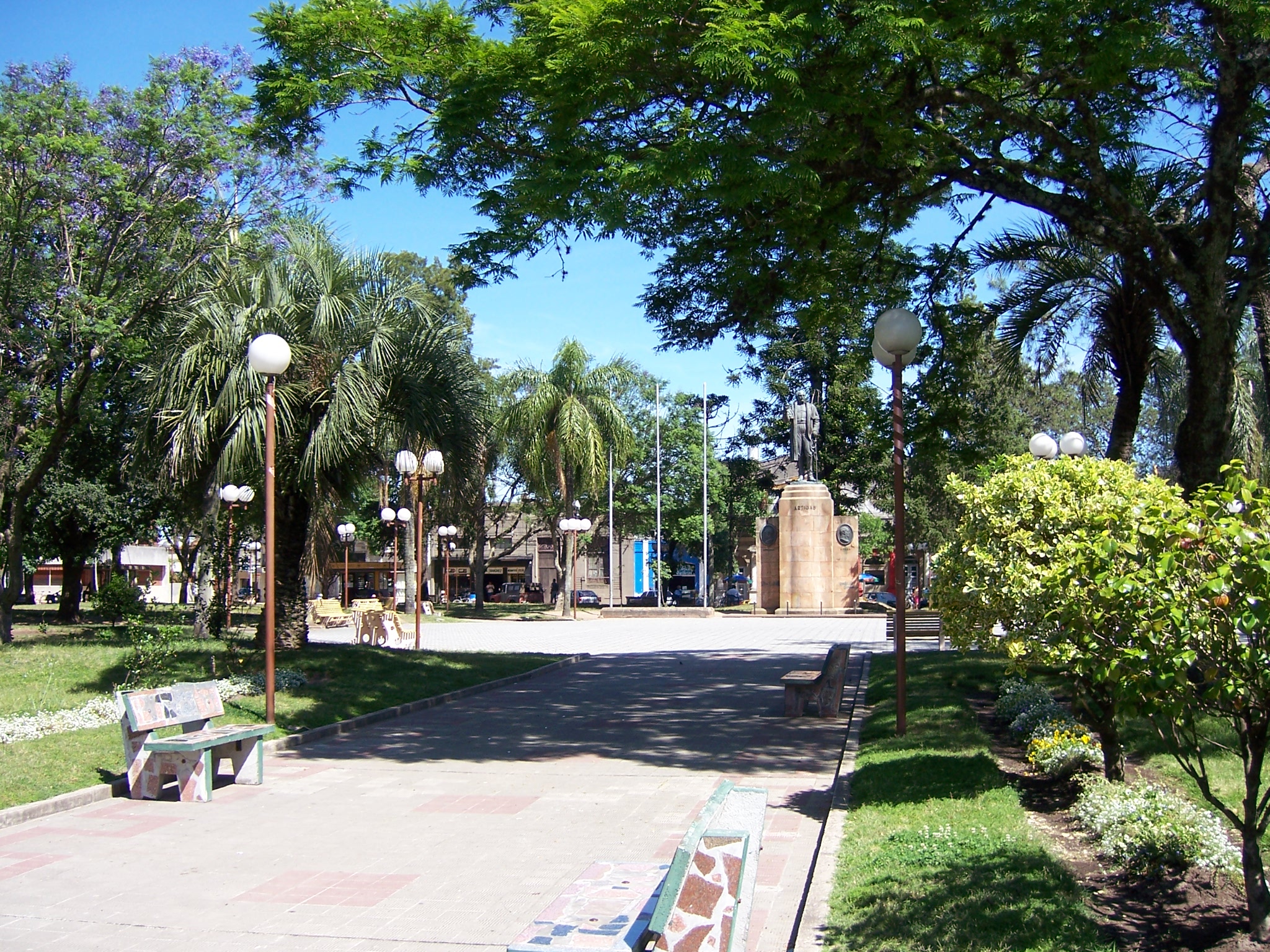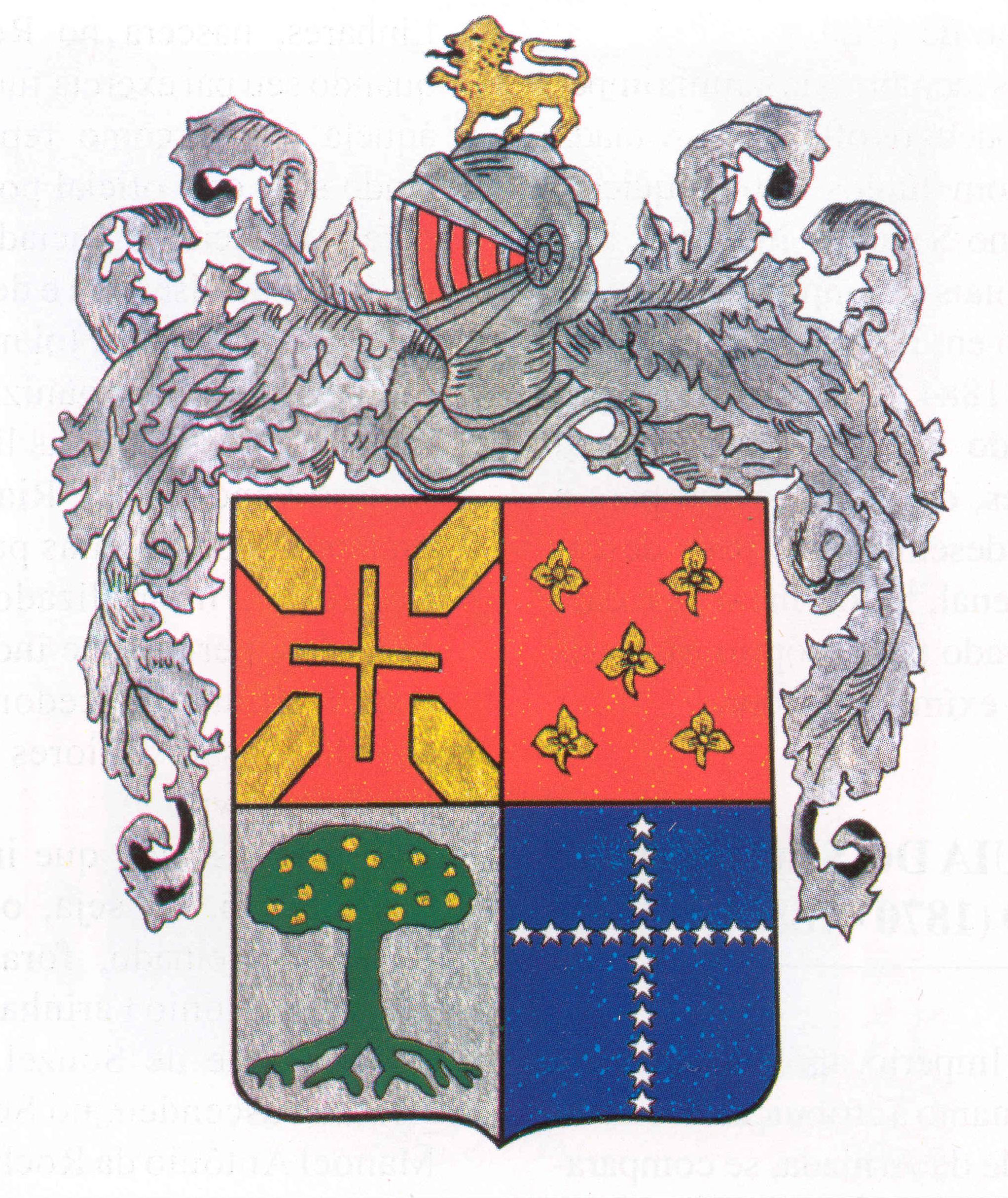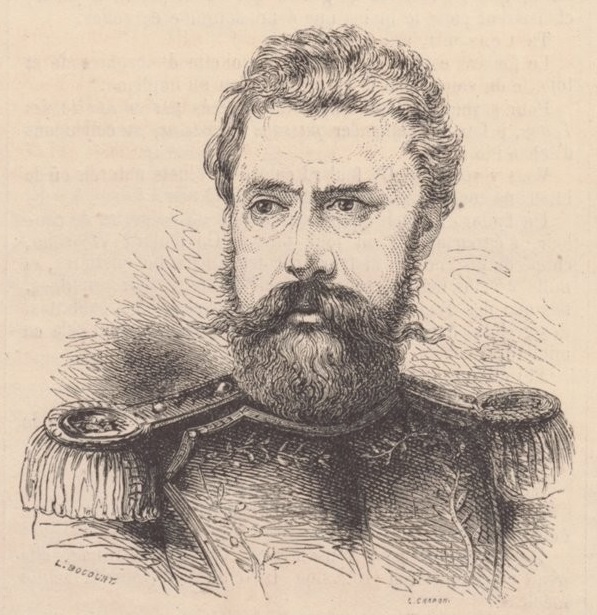|
José Gregorio Suárez
José Gregorio Suárez Moreira was a Uruguayan Lieutenant Colonel and politician who participated in the Uruguayan Civil War, the Paraguayan War and other conflicts throughout the 19th century. He was known for his service during the Battle of Pedernal and the Battle of Estero Bellaco. Youth and the Uruguayan Civil War He was the son of Argentine parents José Suárez and Damasia Moreira and as a young man, he was a commercial employee. He later worked as a herdsman, raised capital and set up shop in the Tacuarembo Department. In 1839, his business was destroyed by the invading forces of Pascual Echagüe and he was taken prisoner, an incident that determined his strong allegiance to the Colorados and the hatred of him by the Blanco Party and the Federalist Party. During the Uruguayan Civil War, he joined the forces of Fructuoso Rivera. He fought in the battles of Arroyo Grande and India Muerta but had to take refuge in Brazil. During the conflict, his mother was locked up in ... [...More Info...] [...Related Items...] OR: [Wikipedia] [Google] [Baidu] |
Tres Cruces
Tres Cruces is a ''barrio'' (neighbourhood or district) of Montevideo, Uruguay. Its name means "three crossings", referring to the three major transportation routes which intersect in the area: Avenida 18 de Julio, Bulevar Artigas and Avenida 8 de Octubre. It is also the starting point of Italia Avenue. Location Tres Cruces shares borders with Cordón to the south and to the west, with La Comercial and Larrañaga to the north, with La Blanqueada and Parque Batlle to the east, Cordón and Pocitos to the south. History In 1813, the barrio was the site of the “Congress Tres Cruces” and the issuance of the "Instrucciones del año XIII" by José Gervasio Artigas in an attempt to establish an independent government for the Liga Federal in what was then known as the "Banda Oriental" ("Eastern Bank"). Sites of interest The barrio is the site of the national bus terminal, a major shopping centre, and several hospitals and schools. Several major monuments are also located here. ... [...More Info...] [...Related Items...] OR: [Wikipedia] [Google] [Baidu] |
Battle Of Sauce (1870)
Battle of Sauce was a Uruguayan battle between the Blancos army under the command of Timoteo Aparicio, and the Colorado government troops, under Colonel José Gregorio Suárez. It occurred on the banks of the Arroyo del Sauce, Canelones Department, during the Revolution of the Lances. History This bloody battle fought on May 25, 1870 concluded with a victory for the government army of General Suárez, who ordered to mercilessly execute a large number of prisoners of the White Army. Among the government troops was Máximo Santos, future Uruguayan president for the Colorado party. In the ranks of Timoteo Aparicio, toke part prestigious revolutionaries of the Uruguayan National Party, including the veteran Anacleto Medina, and the young man Isabelino Canaveris, a patriot who also participated in the Revolución of 1897. References Sauce Sauce In cooking, a sauce is a liquid, cream, or semi-solid food, served on or used in preparing other foods. Most sauces are not ... [...More Info...] [...Related Items...] OR: [Wikipedia] [Google] [Baidu] |
Tacuarembó
Tacuarembó ( Guarani: ''Takuarembo'', literally: "Bamboo shoot") is the capital city of the Tacuarembó Department in north-central Uruguay. Location and geography The city is located on Km. 390 of Route 5, south-southwest of Rivera, the capital city of the Rivera Department. Routes 26 and 31 also meet Route 5 within the city limits. The stream Arroyo Tacuarembó Chico, a tributary of Río Tacuarembó, flows through the north part of the city. As of the census of 2011, it is the eighth most populated city of the country. History On 24 October 1831, a presidential decree by Fructuoso Rivera ordered the creation of a city in the region. The task was entrusted to the President's brother, Colonel Bernabé Rivera. Colonel Rivera left Montevideo on a three-month journey with a caravan of wagons and families, towards the shore of the Tacuaremboty River, which in the Guaraní language means "river of the reeds". The area was surveyed and divided into blocks for settlement. On ... [...More Info...] [...Related Items...] OR: [Wikipedia] [Google] [Baidu] |
San Gregorio De Polanco
San Gregorio de Polanco is a small city in the Tacuarembó Department of northern-central Uruguay. Geography The city is located on a peninsula on the north shore of the artificial Rincón del Bonete Lake and along Route 43, about south of the department capital city of Tacuarembó. Route 43 passes across the lake to Durazno Department by ferryboat. History It was founded on 27 November 1853. On 13 October 1963, its status was elevated to "Villa" (town) by the Act of Ley Nº 13.167, and then on 13 December 1994 to "Ciudad" (city) by the Act of Ley Nº 16.666. In 1945, the artificial lake of Rincon del Bonete hugely changed the landscape of this town, adding a water surface and, later, beaches. Population In 2011, San Gregorio de Polanco had a population of 3,415. Source: ''Instituto Nacional de Estadística de Uruguay'' Places of worship * Nuestra Señora del Carmen, San Gregorio de Polanco, Parish Church of Our Lady of Mt. Carmel References External linksINE map of San ... [...More Info...] [...Related Items...] OR: [Wikipedia] [Google] [Baidu] |
National Army Of Uruguay
The National Army of Uruguay ( es, Ejército Nacional del Uruguay) is the land force branch of the Armed Forces of the Oriental Republic of Uruguay. Organization The army consists of some 15,000 personnel organized into four divisions. His superior is the President of the Republic, who acts as Commander in Chief of the Armed Forces A military, also known collectively as armed forces, is a heavily armed, highly organized force primarily intended for warfare. It is typically authorized and maintained by a sovereign state, with its members identifiable by their distinct .... Educational and instruction * Liceo Militar General Artigas (''General Artigas Military High School'') * Escuela Militar (''Military School)'' * IMAE Instituto Militar de Armas y Especialidades (''Military Institute of Weapons and Specialties'') * IMES Instituto Militar de Estudios Superiores (''Military Institute of Higher Studies'') * Escuela de Ingenieros del Ejército (''Army Engineers Scho ... [...More Info...] [...Related Items...] OR: [Wikipedia] [Google] [Baidu] |
Joaquim Marques Lisboa, Marquis Of Tamandaré
Joaquim Marques Lisboa, Marquis of Tamandaré (Rio Grande, December 13, 1807 – Rio de Janeiro, March 20, 1897) Porto-Alegre, Achylles. Homens Illustres do Rio Grande do Sul. Livraria Selbach, Porto Alegre, 1917. was a Brazilian admiral of the Imperial Navy of Brazil. He dedicated his life to the Brazilian Navy, including a life-long membership in Brazil's Military and Justice Council, then Supreme Military Court, from its inception until 1891, when the Republican Government granted him leave. A national military hero, he stands as the patron of Brazil's Navy, one of whose mottoes goes: "We belong to the undefeated Armada of Tamandaré". His birthday, December 13, was chosen by one of Brazil's foremost navy's minister in the early twentieth century, Admiral Alexandrino de Alencar, as the country's national Sailor's Day, on 4 September, 1925. As a young leftenant, Tamandaré took part in Brazilian War of Independence, in the repression of the Confederation of the Equator, and ... [...More Info...] [...Related Items...] OR: [Wikipedia] [Google] [Baidu] |
Venancio Flores
Venancio Flores Barrios (18 May 1808 – 19 February 1868) was a Uruguayan political leader and general. Flores was President of Uruguay from 1854 to 1855 (interim) and from 1865 to 1868. Background and early career In 1839, he was made political chief of the department of San José. He fought in the "Guerra Grande" against Manuel Oribe and his Argentine backers. He became a leading figure in the Colorado Party and formed a triumvirate with Fructuoso Rivera and Juan Antonio Lavalleja in 1853. First Presidency of Uruguay (interim) He served as interim President of Uruguay and remained in power until August 1855, when overthrown by the Blanco president Manuel P. Bustamante, which resulted in civil war and Flores taking refuge in Argentina. Civil war role In 1863, he started a rebellion ('' Cruzada Libertadora'' or liberating crusade) against the Blanco president Bernardo Berro, which led to civil war in Uruguay.Hooker, T.D., 2008, The Paraguayan War, Nottingham: Foundry Books ... [...More Info...] [...Related Items...] OR: [Wikipedia] [Google] [Baidu] |
Empire Of Brazil
The Empire of Brazil was a 19th-century state that broadly comprised the territories which form modern Brazil and (until 1828) Uruguay. Its government was a representative parliamentary constitutional monarchy under the rule of Emperors Dom Pedro I and his son Dom Pedro II. A colony of the Kingdom of Portugal, Brazil became the seat of the Portuguese colonial Empire in 1808, when the Portuguese Prince regent, later King Dom John VI, fled from Napoleon's invasion of Portugal and established himself and his government in the Brazilian city of Rio de Janeiro. John VI later returned to Portugal, leaving his eldest son and heir-apparent, Pedro, to rule the Kingdom of Brazil as regent. On 7 September 1822, Pedro declared the independence of Brazil and, after waging a successful war against his father's kingdom, was acclaimed on 12 October as Pedro I, the first Emperor of Brazil. The new country was huge, sparsely populated and ethnically diverse. The only ot ... [...More Info...] [...Related Items...] OR: [Wikipedia] [Google] [Baidu] |
Fructuoso Rivera
José Fructuoso Rivera y Toscana (17 October 1784 – 13 January 1854) was a Uruguayan general and patriot who fought for the liberation of Banda Oriental from Brazilian rule, twice served as Uruguay's President and was one of the instigators of the long Uruguayan Civil War. He is also considered to be the founder of the Colorado Party, which ruled Uruguay without interruption from 1865 until 1958. He made a controversial decision to almost completely eliminate the native Charrúa during the 1831 Massacre of Salsipuedes. Life Rivera was a rancher who joined the army of José Gervasio Artigas in 1810. Eventually he rose to the rank of general. When Banda Oriental was occupied by the United Kingdom of Portugal, Brazil and the Algarves and the defeated Artigas forced into exile in 1820, Rivera stayed in the newly created Cisplatina province. Rivera first met with Juan Antonio Lavalleja in 1825, during an event that would become known as the Abrazo del Monzón (Embrace of th ... [...More Info...] [...Related Items...] OR: [Wikipedia] [Google] [Baidu] |
Federalist Party (Argentina)
The Federalist Party was the nineteenth century Argentine political party that supported federalism. It opposed the Unitarian Party that claimed a centralised government of Buenos Aires Province, with no participation of the other provinces of the custom taxes benefits of the Buenos Aires port. The ''federales'' supported the autonomy of the provincial governments and the distribution of external commerce taxes among the provinces. The federalists advocated a form of political organization that would ensure coexistence between autonomous provinces and a central government with limited powers. They took as a model the federalism of the United States. The view on its historical leader is controversial. Juan Manuel de Rosas is considered by his detractors as a "dictator". Among the various possible ways of characterizing him, his supporters call him a "man of order."http://biblioteca.clacso.edu.ar/clacso/otros/20130610085809/ANSALDI.pdf Ideology and principles They promoted econo ... [...More Info...] [...Related Items...] OR: [Wikipedia] [Google] [Baidu] |
National Party (Uruguay)
The National Party ( es, Partido Nacional, PN), also known as the White Party ( es, Partido Blanco), is a major political party in Uruguay. It was founded in 1836 by Manuel Oribe, making it the country's oldest active political party, and together with the Colorado Party, its origin dates back to the time of the creation of the Uruguayan State. Positioned on the centre-right of the political spectrum, the National Party is ideologically liberal, nationalist, Pan-Americanist and humanist. Considering the interim co-government of the ''Gobierno del Cerrito'' headed by Manuel Oribe, and the Defense Government from Montevideo led by the Colorado Joaquín Suarez, in the middle of the Uruguayan Civil War, and with the exception of the current administration of Luis Lacalle Pou, the PN has ruled the country for 35 years interruptedly throughout its history; This includes constitutional, interim, de facto presidents, and collegiate governments. Although General Manuel Oribe is recogn ... [...More Info...] [...Related Items...] OR: [Wikipedia] [Google] [Baidu] |
Pascual Echagüe
Pascual Echagüe, (16 May 1797 – 2 June 1867) was an Argentine soldier and politician. He served as Governor of Entre Ríos and Santa Fe provinces and Minister of War and Navy during the governments of Urquiza and Derqui. He participated in the Argentine Civil Wars and the Uruguayan Civil War. Minister in Santa Fe Echagüe was born in Santa Fe in 1797 and received a doctorate in theology in 1818 from the National University of Córdoba. He was a teacher for a short time, later secretary and afterward provincial minister to Governor Estanislao López. He represented his province at the signing of the treaties with Entre Ríos (1823), and at the Pacto Federal in January 1831. He served several times as interim governor, and joined the army with the honorary rank of lieutenant colonel. He took part in the 1829 campaign against the Unitarian Juan Lavalle, fighting at the Battle of Márquez Bridge. He went with the army against Córdoba Province, and was in charge of th ... [...More Info...] [...Related Items...] OR: [Wikipedia] [Google] [Baidu] |




